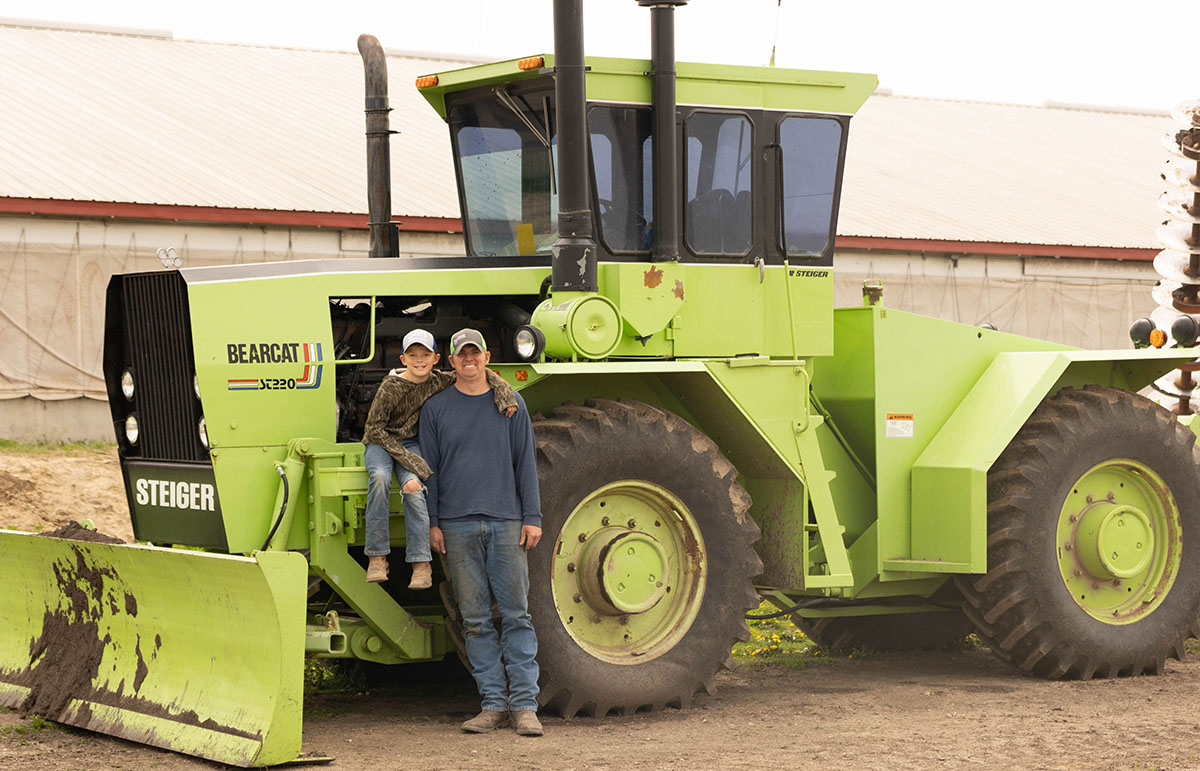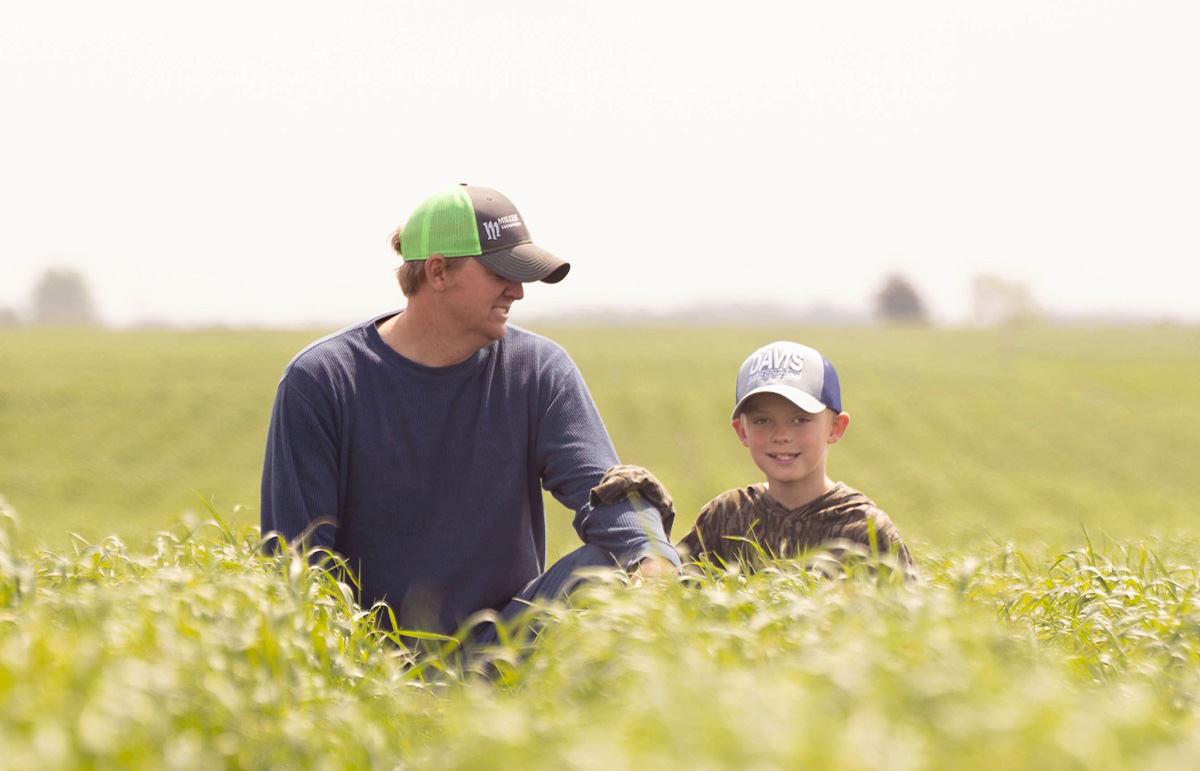
Mark and Oliver Dobson (Photo: Joclyn Bushman/Iowa Soybean Association)
Dobson adds farm value through diversity and conservation
June 1, 2023 | Kriss Nelson
Innovator and environmentalist are just a few words describing how Mark Dobson, owner of reMARKable Farms LLC, approaches farming. Dobson, an Iowa Soybean Association (ISA) farmer-member from Donnellson, describes his farm as a very multifaceted farming operation. He has certified organic and conventional acres and raises soybeans, corn, wheat, hay and cover crops. Not a stranger to growing cover crops, Dobson raises his cereal rye seed but uses the ground cover for soil building and weed control.
“I have been using cover crops before they were cool,” he says, adding that this will be his 17th year planting cereal rye.
Rooted in conservation
Dobson is no stranger to conservation practices. His family started no-till in the 1980s and transitioned into strip-till in the early 2000s. He has embraced his conservationist roots and carries those traditions on his acres. Dobson has collaborated with ISA on various trials revolving around soil fertility and conservation management.
“Through trials, Mark has shown us the value of strip-till,” says Scott Nelson, ISA research agronomist. “He is a leader in the future of production.”

Though Dobson tries to avoid disturbing the soil, there are times tillage is needed to help manage his organic acres. For example, to help combat a widespread breakout of foxtail in his organic acres, Dobson plowed. Within four hours, he had leveled and seeded cereal rye. Dobson says managing his organic acres is a bit different than managing his conventional acres. While conventional farming typically uses chemical fertilizers to promote plant growth, organic farming relies more on manure and compost to fertilize the soil.
“I may do things that aren’t considered conservation-minded on my organic acres, but my soil is never naked for six months a year,” he says. “If I were completely conventional, there would always be something growing on my fields.”
Manure is Dobson’s nutrient source on his organic acres. Cereal rye is planted after the manure is applied to keep the nitrogen from departing the field. Dobson also does his own tiling and terrace construction.
“Cover crops only take you so far in protecting soil loss,” he says. “Surface and subsurface drainage are also important pieces of the puzzle.”
Innovating for change
Dobson is fearless in trying new things on his farm, including adapting machinery. To help with weed control, he uses a weed zapper and hopes to rely on heavier stands of cereal rye — up to nearly 5 bushels to the acre, to take advantage of the biomass. To achieve this goal, he is building a precision drill. Using John Deere Max Emerge 5 twin-row units on two ranks, his homemade drill will be a 24-row unit on 8-inch centers. Dobson plans to raise the organic cereal rye seed he will plant ahead of his organic soybeans.
“I am planning to no-till my soybeans into that rye with the same precision drill, roll the rye once and get by with running the weed zapper twice and not disturb the ground,” he says.
Dobson has purchased a detasseling machine. He is mounting a seeder onto the machine to seed cereal rye into standing corn. He realizes passersby may point and laugh, but that does not bother him. Being innovative with machinery helps Dobson prepare for what he believes is inevitable.
“For conservation, I think we will soon have mandates, and that is fine,” he says. “Why not figure it out now, so when it comes to that you are ready?”
Creating value
Having a layer of biomass from cover crops can be ammunition in the war on weed control. Dobson will use a pre-plant application of 2, 4-D and a residual on his commercial acres to help battle broadleaves. He then plants the soybeans into standing rye and waits until his soybeans have grown 10-15 inches and have achieved a good stand of rye before terminating the cover crop.
“That is our year. There are no additional herbicide costs,” he says. “Those are savings of $10 to $20 an acre. It is real money that can go a long way.”
Adding diversity to the farm with hay acres, the certified organic acres have brought additional value to his farm.
“I have off-farm jobs, and I am working on getting to where I just farm,” he says.
Sustainable production
“Who are you farming for? Are you farming for the next generation?” These are questions more farmers should consider when making management decisions, Dobson says.
Besides protecting the land for future generations, U.S. soybean exports depend on sustainability practices, such as cover crops, reduced tillage and diversification.
“We need to get away from easy button agriculture,” he says. “Let’s show we don’t just grow soybeans, but we grow the best soybeans importers can buy.”
Dobson farms sustainably by using real-time kinematic (RTK) to apply nitrogen, and he is currently involved in an Iowa Nitrogen Initiative nitrogen rate trial. Dobson has replicated blocks of high, medium, low and zero-applied nitrogen rates in his fields. Soil and ear testing will be conducted to help better understand the soil’s nitrogen availability throughout the season.
“Mark is working to help find solutions for problems that fit his area and his operation,” says Nelson. “It is important we understand nitrogen management in his area of southeast Iowa and throughout Iowa.”
These on-farm trials help understand optimum nitrogen rates across variability in weather, soils, genetics and management.
“I’m excited to see the results as I have found traditional nitrogen recommendations are high when planting directly on top of nitrogen applications via RTK,” Dobson says.
Back